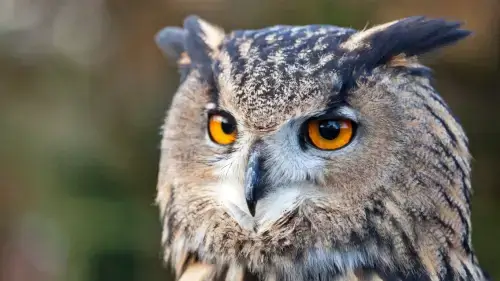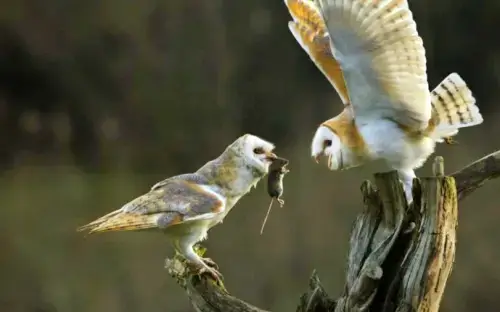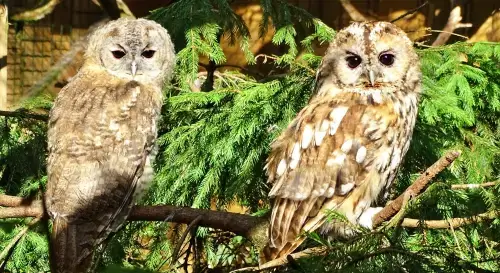Unusual Owl. In the quiet corners of human imagination, the owl reigns as a symbol of wisdom and serene contemplation. We picture it perched on a gnarled branch, a silent, all-knowing guardian of the night, its hoot a lonely echo in the dark.
This image, immortalized in folklore and fiction, is comforting and familiar. It is also profoundly misleading. The truth is that the owl is not a passive philosopher of the forest. It is one of the planet’s most sophisticated and formidable predators, a masterpiece of evolutionary engineering.
Its life is a silent ballet of precision and power, governed by senses that defy human comprehension. These birds fly without a whisper, see in near-total darkness, and hear the faintest heartbeat beneath a blanket of snow.
Unusual owl, but why?
To truly understand the owl is to discard the storybook caricature and step into the world of a creature that is far more complex and fascinating than we have ever dared to imagine.
It is a world of flying paradoxes, a creature that is less a symbol of quiet wisdom and more a machine of deadly accuracy.
An Unblinking Gaze or The Hunter’s Gaze
One of the most captivating features of an owl is its enormous, forward-facing eyes. They seem to hold ancient secrets, but their design is purely practical and brutally efficient.
Unlike the spherical eyeballs of most vertebrates, an owl’s eyes are elongated tubes, shaped more like telescopes. They are fixed in their sockets by bony rings, meaning an owl cannot roll or even glance with its eyes. This is why it must turn its entire head to see.
And what a turn it is. An owl possesses an astonishing ability to rotate its neck up to 270 degrees in either direction a feat that would be lethal for a human.
This incredible flexibility is made possible by a unique skeletal and circulatory system. Owls have 14 neck vertebrae, twice as many as humans, allowing for a far greater range of motion.
Furthermore, their arteries pass through special bony canals that provide slack, preventing the blood vessels from being pinched or severed during extreme head rotations.
This anatomical marvel serves a single purpose: to aim its telescopic eyes. These eyes are built for gathering every available photon of light. Their huge pupils open wide in the dark, and a reflective layer behind the retina, called the tapetum lucidum, acts like a mirror.
Any light that passes through the retina is bounced back for a second chance at being detected, effectively doubling the eye’s sensitivity. This is what gives owls and other nocturnal animals their characteristic “eyeshine” when caught in a beam of light.
It allows an owl to spot a mouse in a dark field illuminated by nothing more than the light of a single candle over 50 meters away.
Contrary to popular belief, however, owls are not blind in daylight. Their pupils can constrict to tiny pinpricks, protecting the sensitive retina from the harsh sun. Their daytime vision is sharp and clear, rivaling that of a hawk.
They simply possess a visual system that is masterfully adapted for both worlds.
Silence in the Sky.
The Secret of the Owl’s Wings.
Perhaps the most uncanny trait of an owl is its ability to fly in absolute silence. A pigeon or a crow taking flight produces a noisy clatter of feathers, but an owl can glide inches from its prey without making a sound.
This ghostly ability is not magic; it is a masterclass in aerodynamics embedded in the very structure of its feathers.
The secret lies in three key adaptations. First, the leading edge of an owl’s primary flight feathers is serrated like a comb. These tiny, tooth-like structures break up the flow of air over the wing, transforming a single, loud rush of turbulence into a series of smaller, quieter micro-turbulences.
Second, the surface of the flight feathers is covered in a soft, velvety down that absorbs the high-frequency sound that remains. Finally, the trailing edge of the wing feathers is fringed and flexible, further dampening any noise as the air leaves the wing.
The result is a flight so silent that it falls below the threshold of human hearing and, more importantly, below that of its prey. A mouse scurrying on the forest floor will hear nothing until the moment the talons strike.
This natural stealth technology is so effective that scientists and engineers are actively studying owl wings to design quieter aircraft, wind turbines, and even computer fans.
More Hunter Than Philosopher.
Hearing is Believing.
The myth of the “wise” owl is often associated with its large head, which we subconsciously equate with a large brain. In reality, much of an owl’s skull is dedicated to its massive eyes and sophisticated hearing apparatus.
Their cognitive abilities are specialized for hunting, not for abstract thought. Their true genius lies in their senses.
While their vision is extraordinary, it is their hearing that elevates them to the status of apex predators. Many owl species have asymmetrically placed ear openings one is higher on the head than the other.
This subtle difference means that sound reaches each ear at a fractionally different time and intensity. The owl’s brain processes these minute differences to create a precise, three-dimensional “sound map” of its surroundings.
This auditory precision allows a Great Gray Owl, for instance, to pinpoint the exact location of a vole moving beneath 30 centimeters (a foot) of dense snow.
It can hear the faint rustle of its prey, calculate its trajectory, and plunge talons-first through the snow to seize it, all without a visual confirmation. It is a feat of sensory integration that is almost impossible to comprehend. They don’t just hear; they see with sound.
The Art of Deception.
Masters of Invisibility.
For all their predatory prowess, owls are also masters of defense, and their primary tool is camouflage. Their plumage is a mosaic of browns, grays, and whites that allows them to blend seamlessly into their environment, whether it’s the bark of a tree or a snowy tundra.
When an owl feels threatened, it can employ remarkable strategies to avoid detection.
If a predator is nearby, an owl might compress its body, pulling its feathers in tight to become a thin, vertical column that perfectly mimics a broken tree branch. It will elongate its body, squint its eyes to mere slits, and remain utterly motionless.
Even experienced ornithologists can walk right past an owl in this state without ever noticing it.
Conversely, if discovered and cornered, the same owl can instantly transform. It will fluff up its feathers, spread its wings to their full, impressive span, and clack its beak menacingly. This sudden change in size is often enough to startle and deter a potential attacker.
Even their young have evolved for stealth. The chicks of some species emit high-pitched squeaks that closely resemble the rustling of insects or the whisper of wind through leaves.
This acoustic camouflage masks their vulnerable calls from the ears of predators, turning the sounds of the forest into a protective shield. Nature has sculpted them into the true ninjas of the night.
A Glimpse into the Owl’s Hidden World.
Recent scientific observation has revealed even more unusual habits that challenge our understanding of these birds. One of the most peculiar is their method of digestion. An owl typically swallows its prey such as a mouse or a vole whole.
Its digestive system dissolves the soft tissues, but the indigestible parts like bones, fur, teeth, and claws are compacted into a neat, firm pellet. Several hours later, the owl regurgitates this pellet.
For biologists, these “owl pellets” are ecological treasure troves. By dissecting them, scientists can create a detailed record of the owl’s diet and, by extension, a census of the small animal populations in a given habitat.
Their social lives are also more complex than previously thought. Many tropical owl species are monogamous, forming lifelong pair bonds.
They often divide their parental duties: the male hunts to provide food, while the female fiercely guards the nest and young.
These pairs communicate through intricate “duet” calls, a series of interlocking hoots and cries that sound almost like a coordinated song. This vocal bonding reinforces their partnership and declares their territory to rivals.
While most owls are nocturnal, some species break the rules. The majestic Snowy Owl of the Arctic, for example, is often diurnal, hunting during the 24-hour daylight of the polar summer.
Others, like many tropical species, are crepuscular, most active during the twilight hours of dawn and dusk. There are even species that have adapted their flight patterns in bizarre ways.
Short-eared owls, for instance, have been observed flying backward against the wind during migration. This counterintuitive maneuver is believed to help stabilize their flight and further reduce wing noise, a small but crucial adjustment in their constant pursuit of silence.
The Flying Paradox.
The owl is a living, breathing paradox. It is a creature of the dark that sees with astonishing clarity, a hunter that moves through the air without a sound, and a listener that can hear through the earth itself.
They are not symbols of static wisdom but dynamic engines of survival, honed to perfection by millions of years of evolution.
The next time you hear a lonely hoot in the night, listen closer. It is not the call of a passive observer, but the voice of a supreme hunter a silent, seeing, and hearing marvel that commands the darkness.
The real story of the owl is one of power, precision, and a profound, wild intelligence that we are only just beginning to understand.
Have a Great Day!






